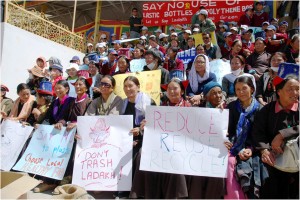Tsewang Dorje
 For many centuries in the past, Ladakh has been a self-sufficient country where more than 90% of the population are dependent on agriculture. Agriculture being the mainstay of the people, they used to live a self-sufficient life by producing their own agriculture food products, handicrafts, livestock’s products akin to the topographical conditions of the region. Besides food, they were entirely dependent on their own traditional means of dresses, architecture, culture and language etc.
For many centuries in the past, Ladakh has been a self-sufficient country where more than 90% of the population are dependent on agriculture. Agriculture being the mainstay of the people, they used to live a self-sufficient life by producing their own agriculture food products, handicrafts, livestock’s products akin to the topographical conditions of the region. Besides food, they were entirely dependent on their own traditional means of dresses, architecture, culture and language etc.
Over the past two decades, there has been rapid change in the Ladakh’s society because of exposure to foreign tourists as well as due to import of consumer products from the plains of India and abroad. The people began to disband their own food habits and traditional crafts. They are switching over to more and more to consumer society. Our own local food productions are being seen as inferior. Ladakh which has a self reliance economy is now dependent on food import from plains of india. The cooperative system which has been the main stay of agriculture workforce is being replaced by paid labour.
The younger generation join either Government service or prefer to work as paid labourer and due to which the farming women are marginalized resulting in abandonment of agriculture. Similarly there has been change in the cultivation process in agriculture. The farmers began to use chemical fertilizers/pesticides to yield bumper crops without looking to the negative side effects and which caused soil erosion and dilution of nutritious values of the food grains. This has been created as a result of rapid development in the name of economic growth and modernization. Apart from this more and more people especially the younger generation have been leaving their native village and heading towards Leh city either in search of Government job or to work as paid labourer resulting in leaving behind old aged couples, agriculture fields, livestock besides tradition & culture.
To mitigate the adverse impact of foreign influences, an organisation called Women’s Alliance of Ladakh has come into existence of Ladakh.
It is a non-profitable, non-Governmental organisation; it was founded in the year 1991 by some eminent local agriculture women farmers. Women’s Alliance of Ladakh has been registered under the Jammu and Kashmir Societies Registration Act of Jammu and Kashmir Government under registration no. 222-S-of 1995, it has a General body of some more than 5000 women’s members drawn from different villages of Ladakh region. Comprising of 12 working committee members which includes the President & Secretary. President is the Chief functionary of the organisation and the working committee is responsible for asking the matters to the general body. This body has come into existence to:
*Create a sense of self respect for Ladakh’s own agriculture.
*Foster self-value for Ladakh’s traditional food.
*Ensure sustainable development of agriculture and traditional crafts.
*Minimize and stop use of chemical fertilizers in agriculture process by the farmers.
*Engage women in traditional agriculture and crafts in their own native village by producing means of income generation for livelihood.
WAL has been working for the last many years for countering the problems as enumerated above. Keeping in view the need to achieve the goal more successfully, the span of project period is required to be continued or extended furthermore, for which there is need to do more campaign by -:
*Holding annual exhibition cum festival of traditional local food and crafts to educate the people to create self respect for own food/culture.
*Holding of village meeting in different areas of Ladakh to discuss and to educate the villagers to keep up traditional agriculture and preservation of their culture.
*Create awareness among the people of Ladakh especially women to counter negative effects created due to rapid development in the name of economic growth and modernization.
*To develop different traditional crafts of Ladakh among women and provide marketing place for the products at women’s Alliance centre leh for income generation to help persuade village women to stay in their native home discouraging abandonment of agriculture.
*Holding of vocational training in various handicrafts for the women for the development of traditional crafts and for forming their own self help groups to generate income for livelihood.
*Holding of Seminars and courses for the women for capacity building.
*Holding of campaign for cleanliness and environmental awareness among the people.
Through this project the Alliance wants to bring change at society level especially among the women to create in themselves a sense of self-respect for agriculture, local foods, traditional dress which have roots in the Ladakh’s cultural heritage. It wants to re-establish the system of co-operation among the farmers which was once the mainstay of agriculture work in Ladakh.
Under this system a group of families /households used to do agriculture farming jointly for each family until the work is finished,. The same system does apply for all works right from shoveling of manure from compost laterine/cow-sheds to ploughing of fields, irrigation of fields, sowing and harvesting etc. It wants to bring a change in the Society at rural level among the women to mobilize themselves in self-help groups to do traditional handicrafts in their respective village during harsh winter when they have to stay indoor without work with the twin objective of earning income for their economic development at one hand and on the other hand to stop them to abandon their native village for headling towards the city/town for search labour work.
Trending Now
E-Paper

